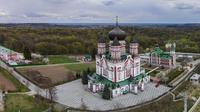Kiev's Hermitage-style Monasteries
Kiev, Ukraine
Trip Type: Historical & Heritage Tours
Duration: 3 hours
Feofania, Goloseevo and Kitaevo are known for their former hermitage style monasteries in the southwest end of Kiev. Now all those communities are flourishing but initially they functioned as “pustun” (Russian for a small secluded community, literally meaning “located in the desert”).
More About This Activity All Historical & Heritage Tours →
Feofania, Goloseevo and Kitaevo are known for their former hermitage style monasteries in the southwest end of Kiev. Now all those communities are flourishing but initially they functioned as “pustun” (Russian for a small secluded community, literally meaning “located in the desert”).
In Kiev a desert meant dense uninhabited woods. There are still 2 monasteries and convent in Kitaevo, Goloseevo and Feofania. Two of them – Trinity monastery in Kitaevo and Pokrov monastery in Goloseevo once belonged to the Kiev Pechersk Lavra Monastery.
Trinity church in Kitaevo was built in 1768 by Stephan Kovnir. The local caves were visited by Empress Elisabeth, daughter of Peter I The Great. She came to Ukraine to be with her new Relatives – the family of her secret husband and former shepherd Alexy Rosumovsky. Elizabeth talked in the caves with monk Dosifei. As all other people she did not know Dosifei was unmarried woman, hiding away from his family and posing for a man. Dosifei is now a saint, whose relic is visited by many pilgrims.
Goloseevo monastery is dedicated to Pokrov (Ukrainian: veil) of the Virgin Mary. All its buildings look unusual for Kiev- they are red color (traditionally Kiev churches are white and green).One of the local churches is called the Spring of Life. In 1930-ies Goloseevo monastery did not functioned, but a woman by name Alipia settled down next to it and prayed. Her dwelling was a hollow in the tree-trunk. Now Alopia rests in the church crypt and pilgrims visit her to ask for help especially in their business life.
Feofania cathedral and other churches are also unusual for Kiev religious architecture. They are all red and white. St. Panteleimon’s cathedral (1914) is the tallest in Kiev.
In Kiev a desert meant dense uninhabited woods. There are still 2 monasteries and convent in Kitaevo, Goloseevo and Feofania. Two of them – Trinity monastery in Kitaevo and Pokrov monastery in Goloseevo once belonged to the Kiev Pechersk Lavra Monastery.
Trinity church in Kitaevo was built in 1768 by Stephan Kovnir. The local caves were visited by Empress Elisabeth, daughter of Peter I The Great. She came to Ukraine to be with her new Relatives – the family of her secret husband and former shepherd Alexy Rosumovsky. Elizabeth talked in the caves with monk Dosifei. As all other people she did not know Dosifei was unmarried woman, hiding away from his family and posing for a man. Dosifei is now a saint, whose relic is visited by many pilgrims.
Goloseevo monastery is dedicated to Pokrov (Ukrainian: veil) of the Virgin Mary. All its buildings look unusual for Kiev- they are red color (traditionally Kiev churches are white and green).One of the local churches is called the Spring of Life. In 1930-ies Goloseevo monastery did not functioned, but a woman by name Alipia settled down next to it and prayed. Her dwelling was a hollow in the tree-trunk. Now Alopia rests in the church crypt and pilgrims visit her to ask for help especially in their business life.
Feofania cathedral and other churches are also unusual for Kiev religious architecture. They are all red and white. St. Panteleimon’s cathedral (1914) is the tallest in Kiev.
« Go Back

